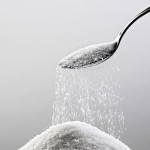
Over the years a large number of reports have been conducted into the links between sugar and dental caries. In 2002 the Joint WHO/FAO Expert Consultation on ‘Diet, Nutrition and the Prevention of Chronic Diseases’ (WHO/FAO 2003), recommendation that free sugars should provide no more than 10% of Energy (E), was largely based on data from population studies. This review was commissioned by the WHO to update the recommendations on sugars.
The aim of the review was to assess the relationship between the level of sugars intake and dental caries using all appropriate randomised controlled trials (RCTs) and observational studies, including cohort, case control, population, ecological and cross sectional studies. Sugars were defined as any of: total sugars, free sugars, added sugars, sucrose, non-milk extrinsic (NME) sugars, expressed as g or kg /day or /yr or as percentage E.
Searches were conducted in the Medline, Embase, Cochrane Database of Systematic Reviews, Cochrane Central Register of Controlled Trials, LILACS (Latin American and Caribbean Health Sciences), CNKI (China National Knowledge Infrastructure), Wanfang (China), and the South African Department of Health databases.
Initial screening was conducted by one reviewer to exclude studies obviously outside of the scope with the remaining studies being subjected to duplicate data abstraction. The Grading of Recommendations Assessment Development and Evaluation (GRADE) system was used to assess study quality.
- 65 papers from 55 studies were included. Only 4 studies were conducted in adults the majority being conducted in children.
- No RCTs were identified. 3 studies (4 papers) were interventions, 8 (12 papers) were prospective cohort, 20 (25 papers) were population, and 24 (25 papers) were cross-sectional.
- The 8 cohort studies were used to generate the GRADE profile for the evidence but the data was not suitable for pooling. Six of the cohort studies reported free sugars or components of free sugars, and 2 reported total sugars. Six out of 8 studies accounted for fluoride exposure.
- Five of the 8 cohort studies identified enabled us to compare dental caries development when sugars consumption was equivalent to a level < 10% E or > 10%
- A consistent association between sugars intake and caries was detected with higher caries with sugars intake > 10% E compared with < 10% E.
- Nine of 10 population studies that enabled a comparison showed lower caries (< DMFT 3) when sugars intake was < 15 to 20 kg/person/yr (< 40-55 g/day < 10% E) compared with higher intakes
- Of the studies, 42 out of 50 of those in children and 5 out of 5 in adults reported at least one positive association between sugars and caries.
The authors concluded
This in-depth systematic review shows consistent evidence of moderate quality supporting a relationship between the amount of sugars consumed and dental caries development.
There is evidence of moderate quality to show that dental caries is lower when free-sugars intake is < 10% E.
Dental caries progresses with age, and the effects of sugars on the dentition are lifelong. Even low levels of caries in childhood are of significance to levels of caries throughout the life- course. Analysis of the data suggests that there may be benefit in limiting sugars to < 5% E to minimize the risk of dental caries throughout the life course.
Comment
This is a large and detailed view of the links between sugar and caries and in addition to the detailed paper in the journal there are no less that 6 additional files that provide significant additional details about the methodology of the review.
Links
Moynihan PJ, Kelly SA. Effect on Caries of Restricting Sugars Intake: Systematic Review to Inform WHO Guidelines. J Dent Res. 2013 Dec 9. [Epub ahead of print] PubMed PMID: 24323509.

I see that this review has been picked up by quite a few of the papers today: http://www.nhs.uk/news/2013/12December/Pages/Daily-sugar-intake-should-be-cut-study-finds.aspx
Has it been well reported on the whole?
Cheers,
André
I think that sealant programs are great. Especially because they target the under served population, however, what about the children who already have cavities. The ones that get a school exam and then are sent home with a piece of paper telling the parent that their child has decay and they are now supposed to find a dentist to take their child to to have those cavities filled or worse that their child has an abscess and needs urgent dental care. In the town I live in there are no dentists that accept Medicaid patients. Children in low income households often have cavities that go untreated because the parent cannot afford the gas money or time off work to take their child to a dentist to be treated. It would be nice if these school sealant programs did more than just preventative work. Here in Rochelle we have been fortunate to find a dentist that does mobile dentistry. He does preventative as well as restorative work in our schools. Our goal is to have our school district cavity free. I only wish more dentists in Illinois would help do this. It is sad that dental disease is 5x more prevalent than asthma especially when we have sealant programs. But if we don’t treat the disease that exists we are only running in circles!